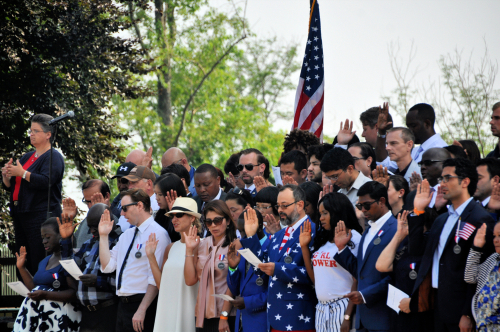Many immigrants dream of becoming a U.S. citizen, but the path can come with many questions, such as what’s the difference between naturalization and citizenship? Simply put, naturalization is how an immigrant becomes a U.S. citizen. Citizenship refers to anyone recognized as a U.S. citizen, regardless of whether you’re born in the U.S. or abroad. With that clarified, we’ve answered some common questions clients ask about the naturalization process and provided some linked resources to help guide your immigration journey.
What are the steps to becoming a U.S. citizen?
Once you’ve reviewed the naturalization requirements and determined your eligibility, the next step is to begin the naturalization application process. All naturalization applicants must submit Form N-400, a naturalization application. You can file this form online or by mail with all supporting evidence and applicable fees. After USCIS receives the application, it will provide a receipt notice with a receipt number, which is the individual case number assigned to the application. You can check your case status online using the receipt number on the USCIS Case Status Online tool.
Next, USCIS may send you a notice for biometrics, also known as a fingerprint appointment. USCIS gathers fingerprint data to conduct a background check. USCIS may waive this appointment if your fingerprints have already been captured your fingerprints have already been captured in the past.
After taking your biometrics, USCIS will transfer the case to the local field office, and the USCIS field office will schedule an interview. Depending on the field office, it may take months to schedule the interview. USCIS sends you a notice of interview with the date, time, and place of the interview. Additionally, the interview notice will contain a list of required documents to bring to the interview.
All naturalization applicants must bring their green card, interview notice, passport (if applicable), and any supporting application documents to the interview. Entry is not permitted without an interview notice.
During the interview, the USCIS officer will first review your N-400 application. After reviewing the information, you will be asked to sign the application again to confirm its accuracy. Then, the USCIS officer will conduct either the English or Civics exams. After conducting one exam, the officer will move to the other exam.
Depending on the field office, you may receive a decision on your naturalization application the same day as your interview. If denied, USCIS should provide the reasons for the denial in writing.
If your application is approved, the next step is to attend the swearing-in ceremony. Some offices hold same-day swearing-in ceremonies onsite, while others will send a notice of decision listing the date, time, and location of the ceremony. Friends and family are typically welcome to attend regardless of when the ceremony takes place.
At the swearing-in ceremonies, everyone being sworn in will state the Oath of Allegiance. Following the Oath of Allegiance, all the new citizens surrender their green cards and receive their naturalization certificates. The naturalization certificate serves as evidence of U.S. citizenship and can be used when applying for a U.S. passport.
How long does the naturalization process take?
Naturalization processing times can vary by jurisdiction. You can check the USCIS website for the average case processing times based on the location of your USCIS field office. While some offices process applications within months, others may take over a year.
What’s the typical cost to become a citizen?
The naturalization application fee for applying online through the myUSCIS portal may differ if you apply by mail. Also, you may file for a fee waiver when applying through either method.
Tips & things to remember
As you start the naturalization process, keep these important tips in mind.
First, lawful permanent residents with pending immigrant visa petitions for their family members may lose the ability to include certain derivative family members on the visa petition, including minor children. If you’re a lawful permanent resident with a pending visa petition for a family member and are considering applying for citizenship, we recommend you consult a legal representative to understand the potential benefits and risks.
Second, moving immediately before or during the naturalization application process may impact a lawful permanent resident’s eligibility to naturalize. To ensure eligibility and/or continuity in the naturalization process, you should double-check that your new residence will be assigned to the same USCIS field office.
Finally, we understand that waiting for a decision or notification of the next step can be stressful. Please keep in mind that processing times vary by jurisdiction, and your jurisdiction is based on where you reside. In the end, the benefits of becoming a U.S. citizen will be truly rewarding.
We know that each immigration case is unique. Please don’t hesitate to contact us with any questions you may have. We’re here to support your immigration needs.

